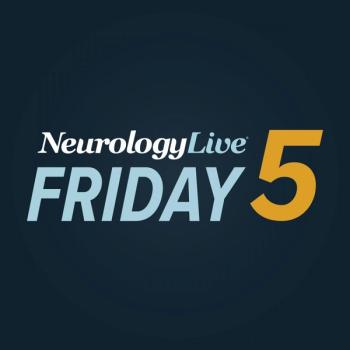
Biogen's Salanersen Shows Promising Phase 1 Data in Spinal Muscular Atrophy
Key Takeaways
- Salanersen, an investigational antisense oligonucleotide, showed safety and efficacy in slowing neurodegeneration in SMA patients previously treated with gene therapy.
- The phase 1 study demonstrated a 70% reduction in neurofilament light and improvements in WHO motor milestones over a 1-year dosing interval.
New phase 1 data revealed salanersen's promise to slow neurodegeneration in spinal muscular atrophy, potentially paving the way for future phase 3 trials.
Newly announced interim data from a phase 1 study showed that treatment with salanersen (Biogen), an investigational antisense oligonucleotide administered once a year, was safe and led to slowing of neurodegeneration in patients with spinal muscular atrophy (SMA) previously on gene therapy. Based on these findings, Biogen plans to test the therapy in phase 3 studies, the design of which is being discussed with the FDA.1
Building on the mechanism of action of nusinersen (Spinraza; Biogen), salanersen is designed to enhance potency and allow for once-yearly dosing, offering potential improvements in convenience and efficacy. Mechanistically, salanersen targets the SMN2 gene, modulating its splicing to increase production of functional survival motor neuron (SMN) protein, which is deficient in SMA.
The phase 1 single-ascending dose trial featured 2 parts: Part A, a randomized and placebo-controlled segment in health adult male volunteers and Part B, an open-label segment in pediatric patients with SMA previously on onasemnogene abeparvovec (Zolgensma; Novartis), the only FDA-approved gene therapy for SMA. The interim data update, which included 24 patients from Part B, showed that 40 mg and 80 mg doses of salanersen was well tolerated, with most adverse events (AEs) mild to moderate in severity.
READ MORE:
Interim findings from the study revealed that patients on the antisense agent had a 70% mean reduction in neurofilament light, a biomarker of neuroaxonal damage, over the 6-month period, which was sustained through the 1-year dosing interval. Presented at the SMA Research & Clinical Care Meeting, hosted by Cure SMA, exploratory outcomes from the trial revealed clinically meaningful improvements in function and attainment of World Health Organization (WHO) milestones over 1 year.
"Of the data generated, to me, it is neurofilament and the WHO milestones that are most easily interpretable, given these children had previously received gene therapy. To see a child dosed with gene therapy at one year of age and still unable to sit without support at age five then gain the ability to sit independently just 3 months after initiating salanersen, that is unexpected,” study investigator Valeria A. Sansone, MD, PhD, clinical and scientific director at the Clinical Center NeMO, University of Milan, said in a statement.1 "Given these are early data from a relatively small cohort, I am looking forward to further understanding the effects that salanersen can have in both previously treated and treatment-naïve individuals in the upcoming Phase 3 studies."
Within the released data was a subgroup of patients, aged 2-12, with at least 1 year of follow-up time who received 40 mg of salanersen. Among this group (n = 8), half (n = 4) of the patients achieved new WHO motor milestones that they previously could not achieve on their own or required assistance to do, such as walking, crawling, standing, or sitting. Improvements in motor function were also observed, reflected by a 3.3-point mean change (SD, 4.46) in Hammersmith Functional Motor Scale-Expanded and a 5.3-point improvement in Revised Upper Limb Module.
"Despite the remarkable therapeutic advancements in the field of SMA over the past decade, there remains critical unmet needs. Salanersen represents the next phase of Biogen's ongoing pursuit to address these needs,” Stephanie Fradette, PharmD, head of the Neuromuscular Development Unit at Biogen, said in a statement.1 "We are encouraged by the available data and eager to move salanersen into the next stage of development as quickly as possible."
Nusinersen, the drug salanersen is modeled off of, was approved by the FDA as a treatment for pediatric and adults with SMA in 2016, becoming the first approved medication specific to treat SMA.2 Since its approval, more than 14,000 individuals have been treated worldwide, spanning across 71 different countries.
Earlier this year, the FDA accepted a supplemental new drug application (sNDA) for a higher, potentially more efficacious dose regiment of nusinersen. The higher dose regimen includes a faster loading phase with two 50 mg doses administered 14 days apart, followed by a higher maintenance dose of 28 mg every 4 months, compared with the standard regimen of 12 mg/5 mL injection. The sNDA was based on findings from the phase 2/3 DEVOTE study (NCT04089566), a randomized, controlled, dose-escalating trial that comprised of 145 participants across ages and SMA types at 42 sites around the globe.3
REFERENCES
1. Biogen to Advance Investigational Spinal Muscular Atrophy Asset to Registrational Studies Based on Positive Interim Phase 1 Results. News release. Biogen. June 25, 2025. Accessed June 26, 2025. https://investors.biogen.com/news-releases/news-release-details/biogen-advance-investigational-spinal-muscular-atrophy-asset
2. FDA approves spinraza (nusinersen) for the treatment of spinal muscular atrophy in pediatric and adult patients. News release. FDA. December 23, 2016. Accessed June 26, 2025. accp1.org/accp1/5publications_and_news/fda_approves_spinraza.aspx
3. FDA and EMA Accept Applications for Higher Dose Regimen of Nusinersen in SMA. News release. Biogen. January 23, 2025. Accessed June 26, 2025. https://www.biospace.com/press-releases/fda-and-ema-accept-applications-for-higher-dose-regimen-of-nusinersen-in-sma
Newsletter
Keep your finger on the pulse of neurology—subscribe to NeurologyLive for expert interviews, new data, and breakthrough treatment updates.



































